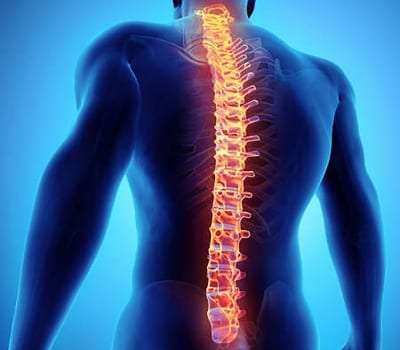 No matter where radiculopathy occurs in the spine, it is a painful condition resulting from the irritation of a nerve as it exits the spinal column. Commonly referred to as a “pinched nerve,” radiculopathy is usually experienced later in life due to regular “wear and tear” adjustments that occur in the spinal cord. However, even younger people can experience radiculopathy after an injury.
No matter where radiculopathy occurs in the spine, it is a painful condition resulting from the irritation of a nerve as it exits the spinal column. Commonly referred to as a “pinched nerve,” radiculopathy is usually experienced later in life due to regular “wear and tear” adjustments that occur in the spinal cord. However, even younger people can experience radiculopathy after an injury.
What Is Radiculopathy?
The word “radiculopathy” comes from the Latin word “radix” meaning “root,” and the Greek word “pathos” meaning “disease.” “Radiculopathy” is the medical term for any compression or irritation of a nerve as it exits the spinal column.
In the case of cervical radiculopathy, the compressed or irritated nerve root is in the neck (the cervical spine), causing neck pain often referred to as a “pinched nerve.” The spinal cord nerve roots in the neck primarily control sensations in the arms and hands where pain, numbness, tingling, and weakness from a compressed or irritated nerve is most likely to occur.
With lumbar radiculopathy, the irritated nerve root is in the lower back, and causes pain that radiates from the lower back into the legs, often called “sciatica.”
Thoracic radiculopathy, although rare, is a pinched nerve in the upper and middle portion of the spine. Potential conditions that could cause thoracic radiculopathy include:
- Degenerative disc disease.
- Bulging disc.
- Herniated disc.
- Osteoarthritis.
- Bone spur.
- Spinal injury.
- Spinal stenosis.
- Foraminal stenosis.
For the remainder of this article, we are going to focus on cervical radiculopathy, since thoracic radiculopathy is uncommon, and we have detailed information about lumbar radiculopathy in our article about sciatica.
What Causes Cervical Radiculopathy?
There are seven cervical vertebrae at the top of the spine that support the skull and enable movement in the head and neck. The nerve roots in the cervical spine travel down the neck into the arms and hands. Along the way, these nerves supply sensation (feeling) to the skin of the shoulder and arm. They also provide electrical signals to certain muscles to move the arm or hand.
A part of the normal aging process is a degeneration of the cervical spine which results in mechanical problems in the neck. This aging of the vertebrae and discs in the neck is called Cervical Spondylosis, a normal “wear and tear” that does not cause any symptoms in many people. However, Cervical Spondylosis can lead to the irritation, or pinching, of a nerve in the neck (Cervical Radiculopathy).
When a nerve is irritated or pinched, by either a bone spur or a part of the intervertebral disc, it can cause weakness in a muscle, numbness in the skin, and pain.
What are the Symptoms of Cervical Radiculopathy?
The symptoms of radiculopathy vary depending on which nerves are affected. When a nerve root is compressed, it becomes inflamed, causing a sharp pain that worsens with certain activities or even something as simple as a cough or sneeze. Cervical Radiculopathy symptoms radiate out away from the neck. Although the problem relates to the cervical spine, the symptoms may appear in the shoulder, the arm, or the hand.
Primarily the symptoms of Cervical Radiculopathy are pain that spreads into the arm and neck. Sometimes the pain occurs in the chest, upper back, and/or the shoulders. Cervical Radiculopathy may cause muscle weakness as well as numbness or tingling in fingers or hands. In some cases, the patient may experience a lack of coordination in the hands.
Someone suffering from Cervical Radiculopathy may also experience neck pain and headaches in the back of their head, referred to as occipital neuralgia and sometimes called occipital headaches (because the back of the neck is known as the “occiput”).
How is Cervical Radiculopathy Diagnosed?
Finding the cause of neck pain begins with a complete history and physical examination. Diagnostic tests may be run to ensure we find the exact cause of the pain. In some cases, physical tests may be used to check for muscle strength and reflexes. Ascertaining whether certain movements cause the pain, or worsen the pain, helps identify the affected nerve root.
Imaging tests, such as an X-ray, CT scan, or MRI scan, are used to see body structures. Nerve conduction studies, along with electromyography, can also be used to help pinpoint whether the problem is neurological or muscular.
How is Cervical Radiculopathy Treated?
Neck pain relief from Cervical Radiculopathy treatments varies depending on the cause, as well as many other factors. Nonsurgical treatment is typically recommended first, and may include:
Medications. Medications will not stop the degeneration, but will help control the pain. Medication that may be helpful include nonsteroidal anti-inflammatory drugs, opioid medicines, and muscle relaxants.
Steroid injections. Steroids can help reduce inflammation and relieve pain. They are injected into the membrane that surrounds the spinal cord.
Physical therapy. Typically, physical therapy may include gentle cervical traction and mobilization. In some cases, exercises can help reduce pain.
Cervical collar. A collar is often used to provide support and limit motion while an injured neck is healing. It also helps keep the normal alignment of the neck. Depending on each individual case, cervical collars can be soft (made of foam) or hard (made of metal or plastic).
Cervical Pillow. A cervical pillow can help with pain at night and allow for a better night’s sleep. These pillows are specially designed to provide proper alignment of the spine while sleeping, and decrease the amount of irritation on the nerve roots.
Epidural Steroid Injection (Nerve Block). An epidural steroid injection places a small amount of cortisone into the bony spinal canal. Cortisone is a very strong anti-inflammatory medicine that may control the inflammation surrounding the nerves and may ease the pain caused by irritated nerve roots. An epidural steroid injection is not always successful, but may help when other conservative measures do not work, while also helping to postpone surgery.
Surgery. When more conservative measures do not succeed, surgery may be recommended if there is significant compression of a nerve. Surgery may also be necessary when significant motor weakness is involved. Surgery is typically used to reduce nerve root pressure by widening the space where the nerve root exits the spine. It may include removing all or parts of a disc and possibly the vertebrae.
How to Avoid Cervical Radiculopathy
While prevention of Cervical Radiculopathy is not always possible, staying physically fit and maintaining a healthy weight can reduce the risk of radiculopathy. Also, maintaining good posture while sitting, playing sports, exercising, and lifting heavy objects is also important for preventing injuries.
Novus Spine & Pain Center
Novus Spine & Pain Center is in Lakeland, Florida, and specializes in treating Cervical Radiculopathy. By using a comprehensive approach and cutting edge therapies, we work together with patients to restore function and regain an active lifestyle, while minimizing the need for opiates.
To schedule an appointment, please contact us online, request a call back, or call our office at 863-583-4445.
Cervical Radiculopathy Resources
What is Cervical Radiculopathy (Spine-Health.com)
Radiculopathy(Wikipedia)
Radiculopathy(MedicineNet.com)
Cervical Radiculopathy (WebMD.com)
Cervical Radiculopathy(University of Maryland Medical Center)
Cervical Spondylosis (Patient.info)
Updated: February 22, 2020

